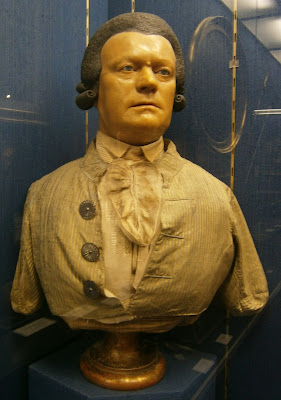Madame Tussauds' has announced that it will be opening its first museum in India at New Delhi by the end of 2017. This iconic two-century old institution will finally allow the enthusiasts in India to rub shoulders with their idols, well, at least with their lifelike wax forms. The addition of the popular Indian icons particularly from Bollywood has made Madame Tussaud’s endearing to the Indian audiences for quite sometime and certainly, a must visit for most traveling to London. But India’s connection to Marie Tussaud the woman who founded the eponymous institution or to be more specific, her curious wax works goes long back in history. The connection stretches back even before Tussaud settled in London and founded her celebrated museum in Marylebone. In this post, we will go back in time and explore this forgotten phase, when the precursor of the Madam Tussaud’s iconic exhibition flourished briefly in India.
The practice of public exhibition of wax figures goes back to the middle-ages. In Europe, lifelike wax figures or effigies of deceased members of the royal families were commonly paraded on royal funeral ceremonies. Following the Renaissance, these wax statues were put to use for more practical purposes. For a long time procuring corpses presented a perennial problem, for the students of medicine and anatomy. So, wax statues began to be used as an alternative of cadavers for teaching anatomy to the aspiring physicians. Philippe Curtius, a physician from Berne, became well-known for achieving perfection in creating such anatomical wax figures. Prince de Conte, a cousin of Louis XV, the French Emperor, while visiting Berne was so impressed with Curtius’models that he immediately offered to patronise Curtius if he decided to turn his talents to portraiture from medicine and sets up an exhibition in Paris. An offer that Curtius readily accepted and relocated to Paris. His first exhibition consisting of life-like wax figures of the celebrities of the day took place in 1770.
 |
| Philippe Curtius |
Curtius was accompanied to Paris by his housekeeper and her daughter, Marie Gresholtz. Curtius, a bachelor, adopted the daughter of his housekeeper, who soon became an able assistant in Curtius’ exhibition. Curtius’ exhibition at Paris, titled Cabinet de Cire was initially open only to a few invited guests but the exhibition generated enough popular interest and it was soon opened to the public at the Palais Royale. In 1782, Curtius inaugurated a second exhibition at Boulevard du Temple. It was at Boulevard du Temple, that Curtius introduced the Caverne des grands voleurs or the Chamber of Horrors to his exhibition. The Chamber of Horrors, which initially exhibited lifelike figures of notorious criminals of the day, had remained a chief attraction of the Madame Tussaud’s ever since.
Curtius’ exhibition assumed a newer significance a few years later in 1789 when the revolution broke out in Paris. Curtius himself took part in the storming of the Bastille and at the close of the year was presented with an inscribed musket as recognition for being one of the Vainqueurs de la Bastille. The musket is still preserved at the Madame Tussaud’s. Curtius’ was also given the duty of ‘archiving’ the sacrifices made at the altar of the revolution from its initial phase. During the revolution, Curtius and young Mary were kept busy in creating wax models of the heads severed in the guillotine.
In 1793, the mistrust among the revolutionaries gave another turn to the French Revolution, A ‘reign of terror’ was launched as the enemies of revolutionaries were identified and hunted down, Philippe Curtius too fell out of favor, so did his cabinet of curious wax collection. With the business going slow, in 1794, Curtius sent a part of his collection to be exhibited in India under the care of Dominick Laurency, an Italian showman.
No comments:
Post a Comment